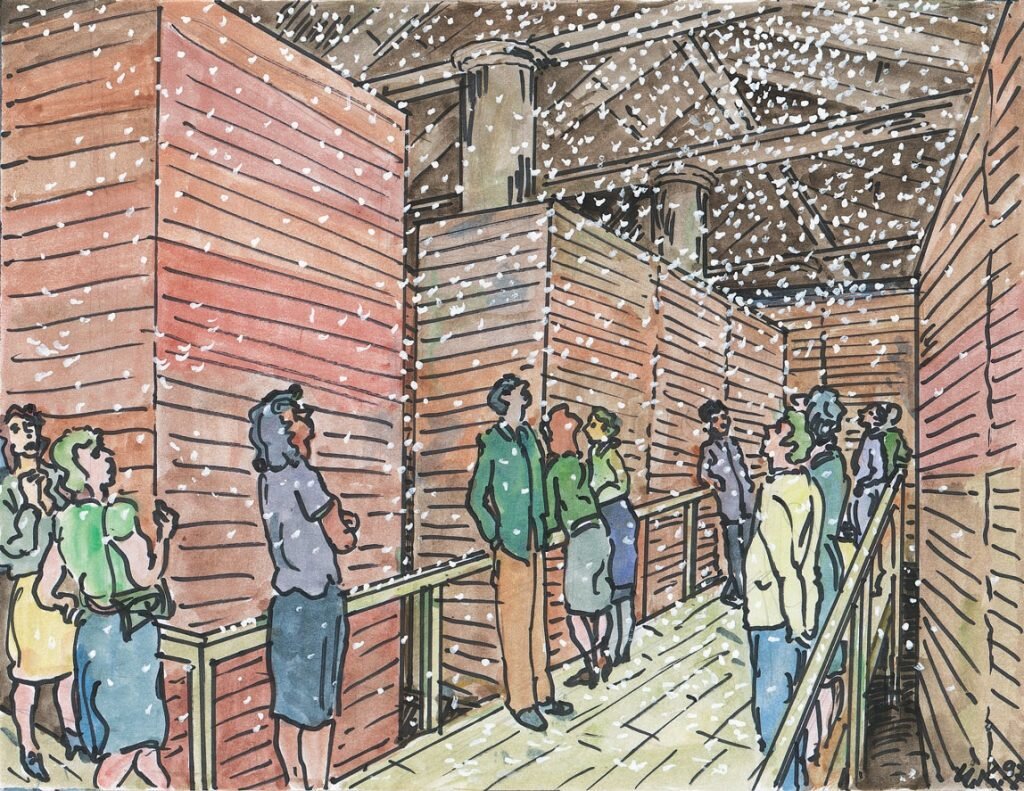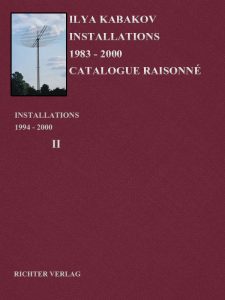We Were in Kyoto
YEAR: 1997
CATALOG NUMBER: 110
PROVENANCE
Collection of the artist
2000, Collection Musée d’Art Contemporain de Montréal, Montreal
EXHIBITIONS
Venice
Futuro, Presente, Passato, 12 Jun 1997 — 9 Nov 1997
Montreal, Musée d’Art Contemporain Montréa
Culbutes: OEuvre d’Impertinence, 18 Nov 1999 — 23 Apr 2000
DESCRIPTION
1- The viewer sees before him a high dark-blue curtain concealing something on three sides, similar to those used in a Circus-Chapiteau. There is an inscription in white letters on the front of this curtain: We Were in Kyoto. The entrance is under the inscription on the right. To the left is the exit from the installation.
2- Right after the entrance, the viewer ascends a small bridge with handrails on both sides, and walks along it until the very exit. On the right and left, almost flush up against the bridge, are tall wooden walls made of discolored boards, so that the only place for the viewer to look is upward.
3- The whole essence of the installation is what is occurring up above, over the viewer. Immediately after entering, he finds himself in a rain of falling petals from blossoming cherry trees. The petals spin and float under a mild ‘wind’ (coming from ventilators installed up above). The entire ‘sky’ above the viewer is covered with these petals, white and pink, that are floating about and lying on his shoulders and on the bridge, and all of this flickering and spinning is dazzled from above by light coming from the windows and from especially aimed lamps producing the unique effect of white ‘flakes’ shimmering in the bright light; the stone space of the ‘corderia’ is not visible at all.
4- The ‘corridor’ has three parts. Having turned the corner, in the middle of the second part, the viewer finds a turn in the path leading into the depth of the ‘street’; a closed door is visible on one of the walls. The entire ‘path’ and the triangle of ‘earth’ in front of it are littered with a pink color. The whole air above this spot is filled with spinning petals which are slowly falling downward. This spot is the middle of the installation; the viewer, standing up above on the bridge, looks down.
Here is a little bit more detail about this middle section of the installation – both the plastic center and the center of meaning of this entire performance installation. Before the bend in the path into the depths, between two wooden walls, a small triangular square is formed. The entire ‘trick’ of the construction of the dramaturgy of the movement of the viewer rests in the fact that for the entire beginning of the installation until this turn and then to its very middle, he is walking inside a narrow corridor of wooden walls that are almost pressed right up against the bridge (see sketch). Then suddenly from the left side, this corridor somehow turns into the depth. But where this ‘street’ leads him remains a mystery: we cannot get off the bridge that is leading us again past the corridor toward the exit.
And it is this area that we see on the left and below the bridge that forms the entire key to the installation. It is not empty. There are three rocks lying in it: a large rock, a medium size, and a smaller one, almost exactly replicating the rocks from the ‘rock garden’ that is well known by visitors to Japan (or at least everyone has seen reproductions). Unwittingly, the viewer pauses in this place to look down at them. And at this moment (naturally, according to my concept), the general conception should begin to work – if, of course, the individual viewer afraid of the petals falling from above and worrying about the cleanliness of his hair and suit doesn’t rush onward in order to get out of this ‘work of art’ quickly. As always, I am counting on the ideal viewer. I am counting on such viewer recalling in his memory the situation of standing on a bridge in the snow, holding onto the parapet – and anyone living in the northern hemisphere has such a memory – and then he will turn off for a moment the awareness that he is in an installation and will for at least a moment, lose himself in that memory.
When I wrote the word ‘snow,’ I did not make a mistake. The thing is that in addition to the rose-colored, rather large petals, there are also white confetti showering down from above that almost imitate and look like snow. The viewer stands on the bridge in the snow, the bridge itself is also covered with the falling ‘snow – flakes’ and the area below and the rocks are also being covered with a white blanket […].
But at the same time, it is also clear that the viewer himself, the longer he stands and the longer he ‘meditates,’ the more he is covered in ‘snow.’ And of course, when he leaves the installation he begins to brush off from his head and shoulders and sleeves all the things that landed on him. Naturally, it will be impossible for him to brush off everything, and so he will walk around the Biennale from pavilion to pavilion with these little white specks. And then he will understand, laughing, why the installation is called We Were in Kyoto. Each person he encounters who carries this white confetti was also ‘in Kyoto.’ And all the viewers of the Biennale are united by this new commonality: they are all travelers who ‘have been in Kyoto.’
And now to the question as to why this concept occurred to me precisely for the Venice Biennale: This installation, it seems to us, is very appropriate to the entire atmosphere of the Biennale in Venice, which is always cheery, light and animated. The time when the cherry blossoms bloom is one of the most important holidays in Japan, especially in Kyoto where an enormous number of people come at that time from all countries and from the entire world – and standing among these trees and under the rain of falling petals, a person might think only about bright and good things, just like, by the way, the festive time of the Venice Biennale.
About Light in the Installation
The illumination must definitely consist of spotlights – bulbs of directed light: in such light the effect can emerge of the nighttime swirling of snowflakes under streetlights; the image of a winter street arises. The arrangement of the lights is also very important for the light-drama: in the first corridor, there should be up above 3 rather bright lights, in the long horizontal (main) one there should be only one light over the ‘square with rocks’ and then a light corridor again, the corridor leading to the exit. The semi-dark intervals between the corridors and the center only serve to prolong and ‘romanticize’ the passage along the main corridor.
Images
Literature









